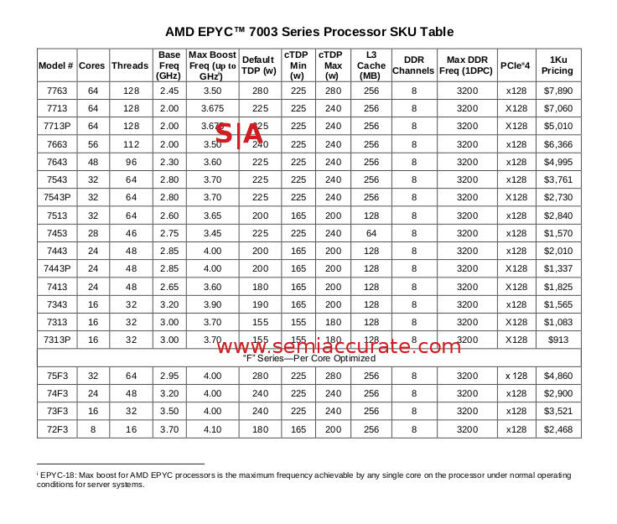 Earlier this week AMD launched a few new 3rd Gen ‘Milan’ Epyc CPUs. Other than the question of , “Why now?”, there are some important nuances to look at that shed some interesting light.
Earlier this week AMD launched a few new 3rd Gen ‘Milan’ Epyc CPUs. Other than the question of , “Why now?”, there are some important nuances to look at that shed some interesting light.
Lets start it out with the obvious, a look at the six new SKUs from AMD. They range from the new, there were no mainstream 8C Milans before, to massive price cuts on the rest. One other bit, four of those six new Epycs are single socket variants (-P suffix) which may explain some of the MSRP cut. Lastly the 16C SKUS are slightly slower than existing options but also use a bit less wattage. If you are thinking this launch is little more than codifying popular existing but not public OEM/volume customer options, you would probably be right.
A little polish makes the old look new
The old is still old though
Now on to the interesting stuff, what the spin on this launch is. It starts out with the usual customer demand, more options, and all the rest but it likely just comes down to price. Milan is a great CPU, the way it dominated Intel in the market is proof positive of that. When Genoa launched it was much much bigger, better too in many aspects, but definitely not cheaper. The rumored price increases SemiAccurate was told about seemed to not stick in light of market conditions, DDR5 prices, and a lot more smaller issues. Genoa is a good chip and did sell, but didn’t set the market on fire unless you compare it to Sapphire Rapids sales. AMD helpfully compares both to the new Milans in TCO.
Looks good until…
Now comes the things we take issue with, and AMD really takes the low road here. Lets use the first graph to explain why. It looks like a fair comparison and the CPUs chosen are the most comparable in price to the AMD 8C ones. Total system prices are listed as $2635 for AMD, $3704 and $2572 for the Sapphire and Ice systems respectively. If you follow the links to the AMD, Sapphire, and Ice machines, you will see they all have 2x the memory of the AMD systems. A quick peek at several etailers shows that DDR4 runs about $2.50/GB and DDR5 about $5/GB so about $320 and $640 cost differential respectively. We won’t dig in to the specific chassis and the rest but a roughly 10% difference on the DDR4 and 20% difference on the DDR5 system prices make a significant difference on the price side. AMD still wins but this kind of behavior colors the whole presentation, and not in a positive way.
We will skip the second graph and move on to the third one, but both of these compare 1S AMD devices to 2S Intel ones. If you know anything about how systems are made, and eventually priced, a 2S system requires a vastly more complex motherboard and 2x the DIMMs, not to mention more expensive 2S capable CPUs vs cheaper 1S variants, see above for the AMD deltas. In any case there is basically no reason to do this at the core counts AMD is showing off, really.
On top of this the AMD system is configured with 256MB of DDR4, the Ice Lake system has 512MB DDR4, and the Sapphire box has 512MB DDR5. You can more or less ignore the delta due to 2x the SSD capacity on the Intel boxes vs AMD but you can’t ignore that roughly $640 and $1280 price delta for the DDR4 and DDR5 boxes respectively. For the record AMD lists their system at $3476, the Sapphire system at $3591, and the Ice Lake machine $4072. There was only a chassis price listed for the AMD and Ice boxes which put the Ice board at ~$300 more, the Sapphire machine will likely be in the same ballpark. Curiously you can get a 24C Xeon Gold CPU 5318N for about $50 _LESS_ than a single 12C 4310 that is compared against. And the 5318N is faster by a little and has a slightly higher TDP than the 4310 but pulls 90W less than a pair of them. With a fair comparison, AMD would lose this one, and lose badly.
Make what you will of comparisons like this, some are wins, others should be losses. That said in the real world with competitive pricing, AMD still isn’t where it wants to be on the low end. Why? The same chiplet architecture that kills Intel at the top kills AMD on the bottom. Rather than point to the strengths of their ‘new’ offerings, comparisons like this just show it’s weakness.S|A
Charlie Demerjian
Latest posts by Charlie Demerjian (see all)
- Qualcomm Is Cheating On Their Snapdragon X Elite/Pro Benchmarks - Apr 24, 2024
- What is Qualcomm’s Purwa/X Pro SoC? - Apr 19, 2024
- Intel Announces their NXE: 5000 High NA EUV Tool - Apr 18, 2024
- AMD outs MI300 plans… sort of - Apr 11, 2024
- Qualcomm is planning a lot of Nuvia/X-Elite announcements - Mar 25, 2024


